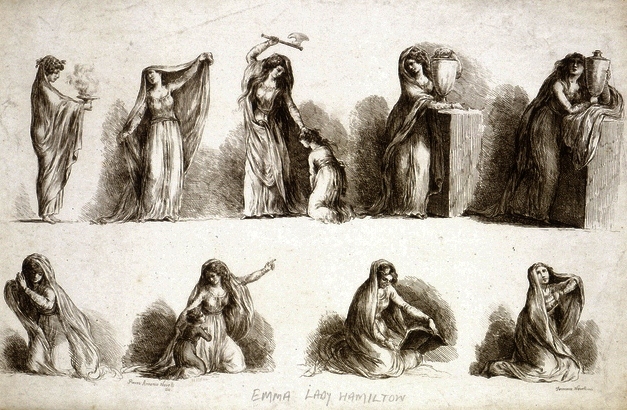
Mimoplastic art (also known as attitudes) is a performance art genre depicting works of art by use of mime, especially gestures and draping. Mimoplastic "attitude" is differentiated from the tableau vivant by its imitation of classical sculpture.[1] The genre depicted works of art, particularly classical subjects.[2]
History[edit]
It was popularized by Emma, Lady Hamilton.[3] Hamilton's art form may have developed after modelling for the painter, George Romney. Goethe wrote in 1787, "with a few shawls (she) gives so much variety to her poses, gestures, expressions etc., that the spectator can hardly believe his eyes... This much is certain: as a performance it is like nothing you ever saw before in your life".[4] The art form trended among upperclass European women between 1770 and 1815. They created mimoplastic art in their homes.[5] Ida Brun's attitudes included background music and narratives.[6] The literary scholar Henning Fenger (1921-1985), stated that Brun's "mimoplastic art captivated Europe".[7] Other notable performers included Henriette Hendel-Schütz[8] and the only male performer of attitudes, Gustav Anton von Seckendorff.
See also[edit]
References[edit]
- ^ Richter, Simon J. (1 August 2004). Goethe Yearbook 12. Camden House. pp. 310–. ISBN 978-1-57113-295-6.
- ^ "Attitude and Shawl Dance". The International Encyclopedia of Dance. Oxford Reference. Retrieved 27 April 2014.
- ^ Pulham, Patricia (2008). Art and the Transitional Object in Vernon Lee's Supernatural Tales. Ashgate Publishing, Ltd. pp. 70–. ISBN 978-0-7546-5096-6.
- ^ Hatfield, Jackie; Littman, Stephen (2006). Experimental Film and Video: An Anthology. John Libbey Pub. pp. 102–. ISBN 978-0-86196-664-6.
- ^ Crochunis, Thomas C. (24 February 2004). Joanna Baillie, Romantic Dramatist: Critical Essays. Routledge. pp. 212–. ISBN 978-1-134-42248-7.
- ^ Preston, Carrie J. (5 September 2011). Modernism's Mythic Pose: Gender, Genre, Solo Performance. Oxford University Press. pp. 264–. ISBN 978-0-19-976626-0.
- ^ Fenger, Henning (1971). Twayne's world authors series. Twayne Publishers. p. 54.
- ^ Carlson, Marvin (16 December 2013). Performance: A Critical Introduction. Routledge. pp. 91–. ISBN 978-1-136-49865-7.
Well, that’s interesting to know that Psilotum nudum are known as whisk ferns. Psilotum nudum is the commoner species of the two. While the P. flaccidum is a rare species and is found in the tropical islands. Both the species are usually epiphytic in habit and grow upon tree ferns. These species may also be terrestrial and grow in humus or in the crevices of the rocks.
View the detailed Guide of Psilotum nudum: Detailed Study Of Psilotum Nudum (Whisk Fern), Classification, Anatomy, Reproduction